Which floor to choose: which option is better + manufacturers review
The benefits of underfloor heating are obvious. A modern floor heating system evenly distributes heat throughout the room, quickly warms up a large area, provides a comfortable temperature in the house.
To decide which floor to choose, you need to get acquainted with the characteristics and features of all types of this equipment and find out what manufacturers offer today.
The content of the article:
Installation of floor heating systems
The underfloor heating system is far from a modern invention. For the first time, visitors to the ancient Roman and Turkish baths experienced it for many thousands of years ago. The source of heat in those days was the heated air passing through the channels made in the stone floor.
Such a system was used until the beginning of the 20th century, when the first pumps appeared, and the air was replaced by heated water. From the middle of the last century, cable structures began to be used. But the most widespread warm floor was about fifteen years ago.
Modern underfloor heating is an integrated floor heating system. It is a kind of layered cake, the filling of which is a system of cables or pipes with thermal insulation, steam and waterproofing layers.
The cake is laid mainly on a concrete base. An alignment layer and a front floor covering are mounted on top of the structure.
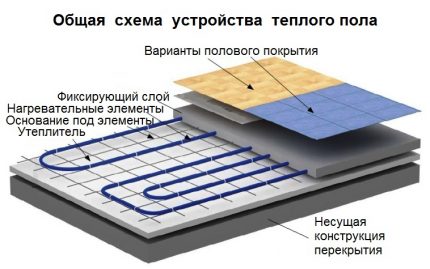
Most often stacked ceramic tile underfloor heating in bathrooms, shower rooms, kitchens, where it serves for additional heating. It is also installed under the laminate and linoleum, less often under carpet. The equipment is often used as the only heating system that replaces traditional radiators.
There are two main types of underfloor heating: water and electric. In the first case, water pipes are used for heating, through which hot water circulates in a constant mode. In electric floors, the surface is heated using an electric cable, infrared film or carbon rods.

In each system, you can find both positive and negative points. The choice of design depends on the installation location, individual characteristics and size of the room, type of front flooring, material capabilities of the owners and other factors.
Benefits of underfloor heating
The warm floor is a worthy alternative to the radiator heating system. The main disadvantages of radiators are: air drying and the creation of convection flows of warm air in the room, moving from floor to ceiling and back.
Such circulation does not allow evenly warming up the whole room, since the heat goes to the ceiling, and the temperature is not quite comfortable on the floor.
Modern floor systems are completely devoid of these shortcomings, they distribute heat throughout the room evenly with a minimum temperature difference on the ceiling and floor of the room. In this case, the warmest air remains below, and the colder rises up.
The heat transfer efficiency does not depend to a small extent on the type of flooring used. So, it is not recommended to install heating floors under carpets, in particular under carpet, as well as floors made of natural wood, which have low thermal conductivity.

Another undoubted advantage of the floor heating system is the ability to adjust the temperature. It can be increased or decreased to the required indicators by just turning the thermostat knob.
This allows not only creating the most comfortable environment in the room, but also significantly saving energy consumption. The advantages and disadvantages of each type of underfloor heating are given below.
Features of water design
Water floor heating is a pipeline system, laid between the ceiling and the front floor covering. The room is heated by warm water that flows through the pipes. The fluid is supplied either directly from the central heating system, or from an electric or gas heating boiler.
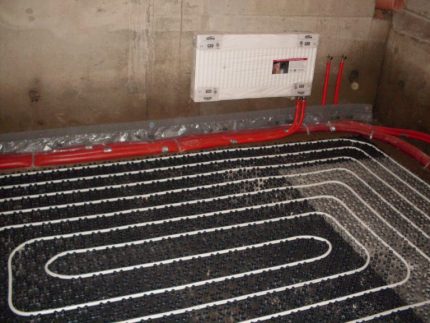
The effectiveness of the water floor is most obvious when used in cottages with a large area. The water system can significantly reduce energy costs.
Savings are achieved due to the low temperature of the coolant, which does not exceed 50 degrees. If a gas or solid fuel boiler is used to heat water, the costs will be even lower. But this is far from his only advantage.
Among other advantages of water floors can be noted:
- compatible with different types of floor coverings, except for wooden;
- can be installed in very humid rooms;
- non-volatile, can function both from electricity, and from gas or solid fuel boilers.
Water floors are mainly installed in private households and very rarely in multi-storey buildings. There is a simple explanation for this. On the water floor a very thick layer of concrete mortar is applied, which puts pressure on the floors (up to 200 kg / 1 m 2). As a result, the load increases significantly, which is extremely dangerous.
Disadvantages of water floor heating are also available:
- complexity in design and high cost of installation work;
- difficult temperature control when connected to central heating;
- a long time to warm up the room (up to 4 hours).
In addition, pipes may be damaged and leaking as a result of operation. If this unpleasant event occurs, water will flow directly to the neighbors, and you will have to completely dismantle the entire floor covering.
Therefore, the use of a water system in multi-storey buildings is prohibited according to technical indicators. To install it requires permission from the management company.
Characteristics of electrical systems
Electric heated floors are universal. They can be installed in private and multi-storey buildings without any coordination. Their installation is simple and is much faster than water. Electric floors easy to adjust, you can set the desired temperature with an accuracy of one degree.
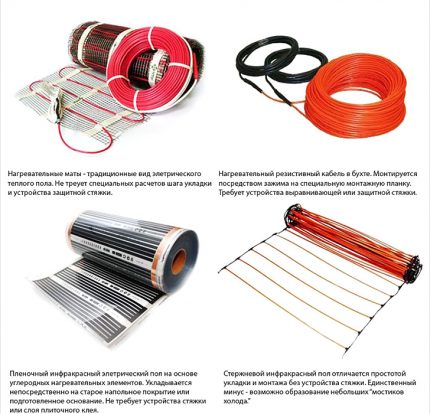
There are two types of underfloor heating, the functioning of which requires electricity. It is convectional and infrared. Their main difference lies in the principle of heating. In the first, a heating cable acts as a heating element, which is produced either in bays or in thermomats.
Infrared floors, although they relate to electrical systems, are a separate group. Heating elements in them are thermal film or special carbon rods.
Electric cable floor
Warm cable floor appeared one of the first, but today it is also relevant, as before. It has a simple design, low cost of materials and installation, can be laid in any room as the main or additional heating. The life of the system reaches twenty years.
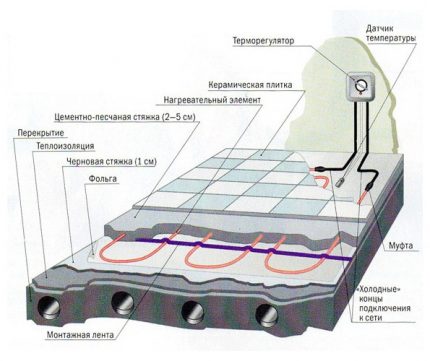
However, despite the relatively low cost of laying, electrical cable systems require considerable financial costs for their maintenance. Cable design and installation require special care. Incorrect miscalculations and inaccurate installation can lead to electrical injuries, which is especially dangerous in wet rooms.
It should be noted also such a minus as the presence of electromagnetic radiation, which is created in the room through the use of a heating cable.
A more modern and improved electric flooring is thermostats, which are a fiberglass mesh on which a heating cable is fixed. The cost of the material is more expensive than the price of the heating cable in the bay, but due to the exact calculation of the required quantity and ease of installation, the final floor price is not much higher than the previous version.
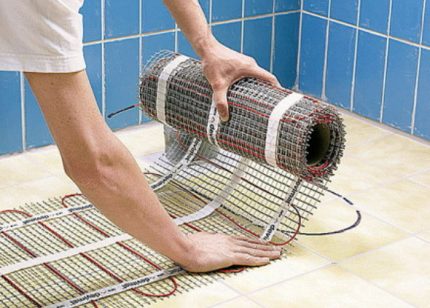
Laying mats is not particularly difficult, even a layman can handle this. If necessary, the mesh can be easily cut into pieces of the desired size and give it any shape. Mats do not require the application of a thick layer of screed, and when mounted under a tile, they can be laid directly under the tile adhesive.
Infrared underfloor heating
Infrared systems are the most advanced type of underfloor heating. They appeared relatively recently, but have already become quite popular. They use innovative technologies.
Heat dissipation infrared floors up to 97%, they are safe for humans, do not create electromagnetic radiation. The failure of the entire system is excluded, since parallel connection of blocks is used.
The principle of operation of a floor heating system is as follows: an electric current passes through the built-in heating elements, which causes infrared radiation that transfers energy. The infrared floor is represented by two types: heating film and carbon rods.
In the film floor, a carbon or bimetallic fiber, enclosed in two layers of a polymer film, which has good dielectric properties, serves as a heating element. Laying of the roll is carried out by dry method without screed, a film-type warm floor is usually laid under a laminate, linoleum and parquet
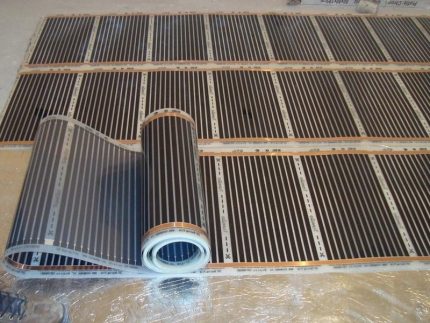
The most advanced floor heating system is the infrared floor with carbon rods. The core floor has a self-regulating ability, which eliminates overheating of the system.
Thanks to this, it can be installed under a wide variety of flooring. It can be placed in rooms with a very high level of humidity. Innovative material has a high cost, but requires minimal costs during operation.
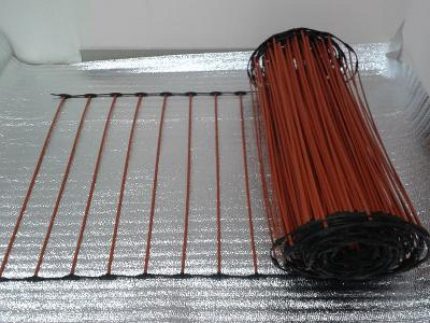
Key points in choosing a heating design
In order to determine the choice of a floor heating system and understand which warm floor is best for laying in a particular case, it is necessary to take into account the following factors:
- The area and height of the floor in the room where the structure will be installed.
- For what purposes is it supposed to use a floor heating system: will it be the only or additional source of heating.
For heating a country house, the best option is water heated floors. They can be installed both at the construction stage and in the finished house. The complexity of the installation will pay off with low energy costs during the operation of the system.
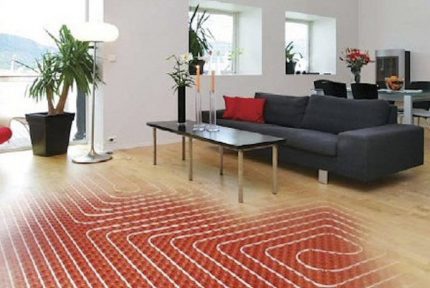
However, here it is also necessary to take into account such factors as climate, temperature indicators of the area, the degree of thermal insulation of the house. Water-type warm floors can be used as the main heating equipment only in well-insulated buildings. In other cases, they are better used as an additional way of heating individual rooms of the house.
To arrange additional floor heating in the apartment, it is better to stay on cable or film electrical construction. The infrared floor is well suited as the only heat source in any room.
However, you need to consider that the electric, especially cable floor, during operation consumes a lot of electricity, so you need to first calculate how beneficial it will be to install.
An equally important parameter for determining the type of floor heating is the situation in the room itself. All systems, except the core, do not withstand overheating.
Furniture and heavy appliances create pressure on the structure and increase the temperature in the system. Therefore, the underfloor heating should be mounted in places free of heavy objects.
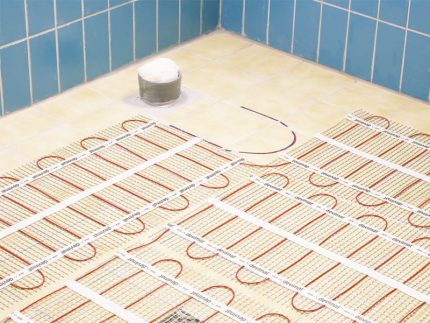
It should be noted that all floor heating structures to one degree or another affect the height of the ceilings. The thickest screed layer is required when arranging water floors - up to 15 cm, the cable floor reduces the height of the ceilings by an average of 5 cm. In film infrared floors this figure is minimized, since they only fit without screed.
Such a characteristic as the maintainability of the system is the same for all underfloor heating. In the event of a breakdown, all of them require complete dismantling of the floor covering. It is also difficult to determine the location of the damaged area, as the screed does not allow access to the elements of the system. The exception is film floors, dry-mounted.
If you focus on the speed of work, then the top three will be thermomats, infrared film and core floors. These systems are installed in one day. However, the floor can only be connected after the screed is completely dry.
The electrical structure can be connected after seven days, and for core floors, manufacturers set a limit of 28 days. The film floor also has the best performance here, which can be used already a day after installation.
In addition to the above indicators, there are many other factors that need to be taken into account when choosing a warm floor: compatibility with the finish flooring, installation location, cost of materials, cost-effectiveness in use.
Top equipment manufacturers
An essential criterion for choosing a floor heating system is its manufacturer. It is not easy to decide which company to choose a warm floor, since many worthy models of both domestic and foreign companies are presented on the Russian market. Meet the best of them.
The Finnish company Devi is considered the recognized leader in the production of underfloor heating. Electric floor systems made with impeccable Scandinavian quality are also distinguished by their affordable cost. They are equipped with a thermostat with an intelligent timer, so the system works with significant savings.
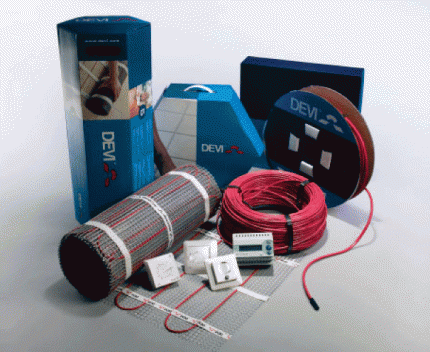
No less high-quality and reliable products are produced by the Finnish manufacturer Ensto. Ensto's electric cable flooring and thermostats have proven their worth in the most adverse conditions. Among the assortment of the company you can find models of different price ranges, the cost of which depends on the capacity of the equipment.
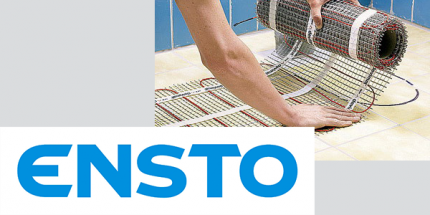
The products of the English company Energy are very popular among Russian consumers. The model line includes six models of heating mats with one and two-wire cable. The manufacturer's innovative development was water floors, which are a pipe system with built-in electric heating.
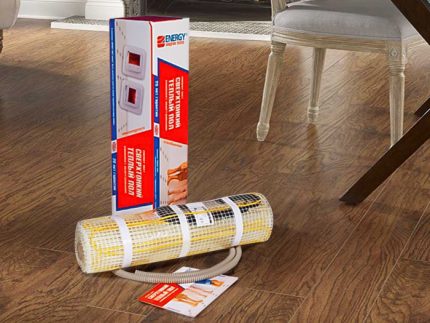
Underfloor heating under the Rehau brand are made with genuine German quality. The company specializes in the production of water floors and electric heating mats with a two-wire cable. The manufacturer offers a complete set of necessary equipment and consumables for installing the system.
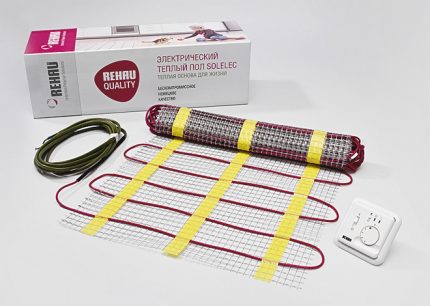
The list of foreign manufacturers will be incomplete, if not to mention the South Korean company Unimat, which conquered buyers around the world with its infrared thermomats. Along with high quality indicators, efficiency and reliability, the warm floor of this brand has an affordable price and a long service life.
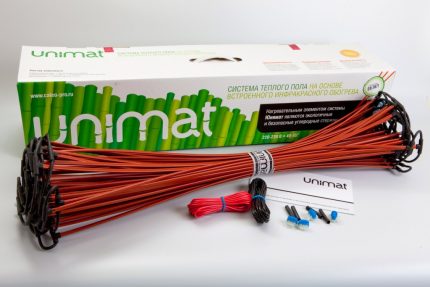
Among domestic manufacturers of warm floor systems, the Special Systems and Technologies factory can be distinguished, which produce heating floors under two brands: Teplolux and National Comfort.
The company's products are exported to forty countries, which speaks for itself. Warm floors are reliable, high quality workmanship and low cost.

Conclusions and useful video on the topic
Video # 1. The features of different electric floor systems can be found in the following video:
Video # 2. How is the installation of the water floor, the video narrates:
Video # 3. How to choose an infrared film floor, see the video:
The warm floor will help create a comfortable atmosphere in the house, but only when the system is correctly selected, the correct calculation is made and the equipment is installed expertly. Therefore, you should not rely on your sometimes superficial knowledge, it is better to consult a professional and entrust all the work to specialists.
Please write comments, ask questions, post photos in the block below. Tell us how you chose a floor heating system for your own country house or cottage. Perhaps you have useful information that you would like to share with visitors to the site and with us?

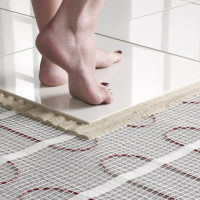 Which underfloor heating is better for tiles: the pros and cons of various solutions + an overview of the best manufacturers
Which underfloor heating is better for tiles: the pros and cons of various solutions + an overview of the best manufacturers 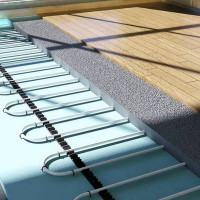 How to choose a warm floor under the laminate: a comparative analysis of the best options
How to choose a warm floor under the laminate: a comparative analysis of the best options 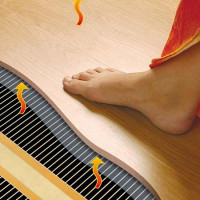 Underfloor heating under the laminate on the wooden floor: which system is better + installation instructions
Underfloor heating under the laminate on the wooden floor: which system is better + installation instructions  How to choose an electric floor heating: guidelines for choosing the optimal heating system
How to choose an electric floor heating: guidelines for choosing the optimal heating system 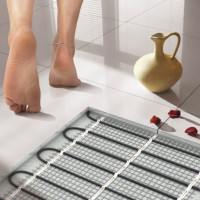 Which warm floors are better: water or electric? Comparative review
Which warm floors are better: water or electric? Comparative review 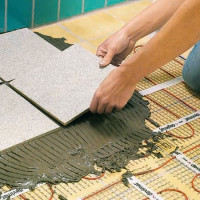 How to make an electric heated floor for tiles: film and cable option
How to make an electric heated floor for tiles: film and cable option  How much does it cost to connect gas to a private house: the price of organizing gas supply
How much does it cost to connect gas to a private house: the price of organizing gas supply  The best washing machines with dryer: model rating and customer tips
The best washing machines with dryer: model rating and customer tips  What is the color temperature of light and the nuances of choosing the temperature of the lamps to suit your needs
What is the color temperature of light and the nuances of choosing the temperature of the lamps to suit your needs  Replacement of a geyser in an apartment: replacement paperwork + basic norms and requirements
Replacement of a geyser in an apartment: replacement paperwork + basic norms and requirements
The problem of heat in my apartment has been since the flower shop appeared on the ground floor. And since they like cold, the hostess refused heating, and now in my room the thermometer does not rise above 18 degrees. I decided that the warm floor will save me from the cold, as ordinary radiators can not cope with their task. I was attracted to the infrared floor system with a carbon rod, it would be ideal, but the author writes that it is not cheap. Can such a system become the only source of heat in the apartment? I want to forget forever about the imperfections of central heating.
I was visiting my friend and as soon as I took off my shoes, the first thing that impressed me was the warm floor. It seems that you walk barefoot on the ground in summer. But it’s still hot in the apartment, the temperature fluctuates between 26-28 degrees, it is stuffy for me, comfortable for a friend and her family. Did I understand correctly that she had an electric cable floor installed? I would like such a heating system in my house, but that would not significantly affect the overall temperature in the room.
If a friend lives in an apartment, then this is in any way an electric or infrared heated floor. You immediately feel them - it’s warm and comfortable under your feet. Underfloor heating will in any case raise the temperature in the room. It all depends on the heating power that you put. Many systems are connected to the controller, where you can set the desired power, or the temperature to which the room will heat up.